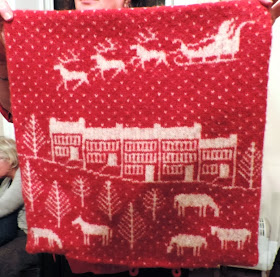 |
| My Wetwang sweater |
It's Ann Kingstone's Wetwang sweater from her Born & Bred book. I started it last April, and wrote about it here. But then I put it away for the summer, until it got cold enough again to want to knit a woolly jumper - by that time, I just had the sleeves to finish. I'm really happy with the result. It fits very well - because it's knitted top-down in one piece, you can try it on as you go. I made it quite close fitting - you can see from the photo that there is quite a lot of shaping at the waist. I also made it long enough - I often find that I make sweaters too short, but again if you can try them on as you go, it's easy to get the length right.
The construction is really clever, I think. You can see from the photo that the front of the neck is much lower than the back. That is all done by short row shaping after the yoke is finished. And at the same time, you are doing the shaping for the top of the sleeves. It's easy to knit - you just follow the instructions - but I wouldn't know how to design something like that.
For anyone else knitting it, I found that the yoke doesn't sit right until you have finished the sleeves. So although you can try it on as you go, you don't actually see how the neckline is going to look until you have nearly finished. But if you just have faith in the pattern, it all comes right in the end.



.jpg)


.jpg)




















